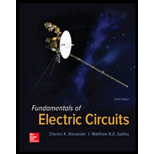
A series RLC network has R = 2 kΩ, L = 40 mH, and C = 1 μF. Calculate the impedance at resonance and at one-fourth, one-half, twice, and four times the resonant frequency.
Find the value of the impedance at resonance and at one-fourth, one-half, twice and four times the resonant frequency.
Answer to Problem 25P
The value of the impedance at resonance
Explanation of Solution
Given data:
The value of the resistor
The value of the inductor
The value of the capacitor
Formula used:
Write the expression to calculate the resonant frequency.
Here,
Write the expression to calculate the impedance at resonance of series RLC circuit.
Here,
Write the expression to calculate the impedance of the series RLC circuit.
Calculation:
Substitute
Simplify the above equation to find
(1) Impedance at resonance:
Substitute
(2) Impedance at one-fourth of the resonant frequency:
Here, the resonant frequency
Substitute
Substitute
Simplify the above equation to find
(3) Impedance at one-half of the resonant frequency:
Here, the resonant frequency
Substitute
Substitute
Simplify the above equation to find
(4) Impedance at twice of the resonant frequency:
Here, the resonant frequency
Substitute
Substitute
Simplify the above equation to find
(5) Impedance at four times of the resonant frequency:
Here, the resonant frequency
Substitute
Substitute
Simplify the above equation to find
Conclusion:
Thus, the value of the impedance at resonance
Want to see more full solutions like this?
Chapter 14 Solutions
Fundamentals of Electric Circuits
- A series RLC circuit has the following parameters: R=40 ohms L=2.5 mH C=0.1 uF find out the impedance at resonance and the series resonant frequency.arrow_forwardThe resonant circuit of a tuned collector transistor has a resonant frequency of 5MHz. If the value of the capacitance is increased by 50%, calculate the new resonant frequency.arrow_forwardIf the resonant frequency in a series RLC circuit is 50 kHz along with a bandwidth of 1kHz, find the quality factor.arrow_forward
- Compute the quality factor of an RLC series circuit: (i) if R= 20 Ω , L =50mH, v0 = 2000 rad/sarrow_forwardCompute the quality factor of an RLC series circuit: (ii) if R= 20Ω , L =50mH, C = 1μFarrow_forwardFor a Hartley oscillator, the value of the two inductors present in the tank circuit are 5 mH, and 12 mH. If the capacitor is 3.5 uF and there is no mutual inductance present, then what will be the resonant frequency of the circuit?arrow_forward
- For the systems below, plot the Bode plot.arrow_forwardA supply voltage of 3 V is applied to a series R–L–C circuit whose resistance is 12 ohms , inductance is 7.5 mH and capacitance is 0.5µF. Determine (a) the current flowing at resonance, (b) the current flowing at a frequency 2.5% below the resonant frequency and (c) the impedance of the circuit when the frequency is 1% lower than the resonant frequency.arrow_forwardA coil is at resonance at 10 KHz with a capacitor. If the resistance & inductance of the coil are 200 Ω & 5H. What is the value of Q factor of the coil? Select one: a. 500. b. 700. c. 1000. d. 1570.arrow_forward
- 2) For the parallel RLC circuit, if i = 2∠0° mA , R = 4 kΩ, C = 20 nF and = 0.1 mH,a) Determine the resonant frequency fp.b) Find the voltage Vc at resonance.c) Determine the currents iL and ic at resonance.arrow_forwardFind the half-power bandwidth of a parallel resonant circuit which has a resonant frequency of 7.1 MHz and Q of 250.arrow_forwardAt what frequency of a series ac circuit consisting of a coil resistance of 10 ohms and inductance 50 mH and capacitance 0.05 μF will resonate. Find also the current flowing at resonance if the supply voltage is 100v.arrow_forward
 Introductory Circuit Analysis (13th Edition)Electrical EngineeringISBN:9780133923605Author:Robert L. BoylestadPublisher:PEARSON
Introductory Circuit Analysis (13th Edition)Electrical EngineeringISBN:9780133923605Author:Robert L. BoylestadPublisher:PEARSON Delmar's Standard Textbook Of ElectricityElectrical EngineeringISBN:9781337900348Author:Stephen L. HermanPublisher:Cengage Learning
Delmar's Standard Textbook Of ElectricityElectrical EngineeringISBN:9781337900348Author:Stephen L. HermanPublisher:Cengage Learning Programmable Logic ControllersElectrical EngineeringISBN:9780073373843Author:Frank D. PetruzellaPublisher:McGraw-Hill Education
Programmable Logic ControllersElectrical EngineeringISBN:9780073373843Author:Frank D. PetruzellaPublisher:McGraw-Hill Education Fundamentals of Electric CircuitsElectrical EngineeringISBN:9780078028229Author:Charles K Alexander, Matthew SadikuPublisher:McGraw-Hill Education
Fundamentals of Electric CircuitsElectrical EngineeringISBN:9780078028229Author:Charles K Alexander, Matthew SadikuPublisher:McGraw-Hill Education Electric Circuits. (11th Edition)Electrical EngineeringISBN:9780134746968Author:James W. Nilsson, Susan RiedelPublisher:PEARSON
Electric Circuits. (11th Edition)Electrical EngineeringISBN:9780134746968Author:James W. Nilsson, Susan RiedelPublisher:PEARSON Engineering ElectromagneticsElectrical EngineeringISBN:9780078028151Author:Hayt, William H. (william Hart), Jr, BUCK, John A.Publisher:Mcgraw-hill Education,
Engineering ElectromagneticsElectrical EngineeringISBN:9780078028151Author:Hayt, William H. (william Hart), Jr, BUCK, John A.Publisher:Mcgraw-hill Education,





